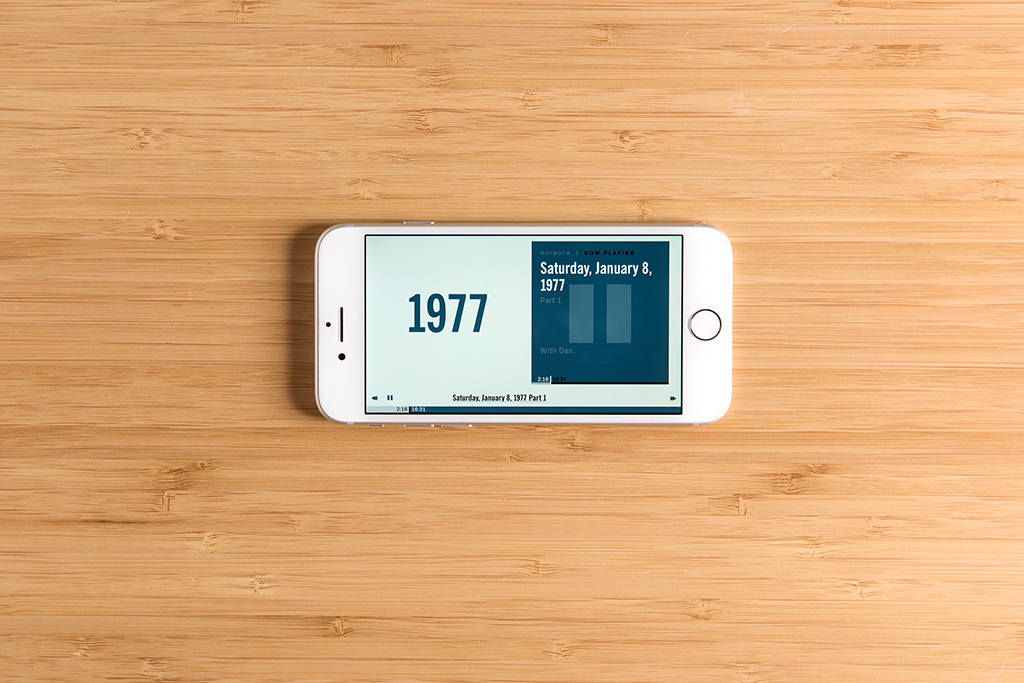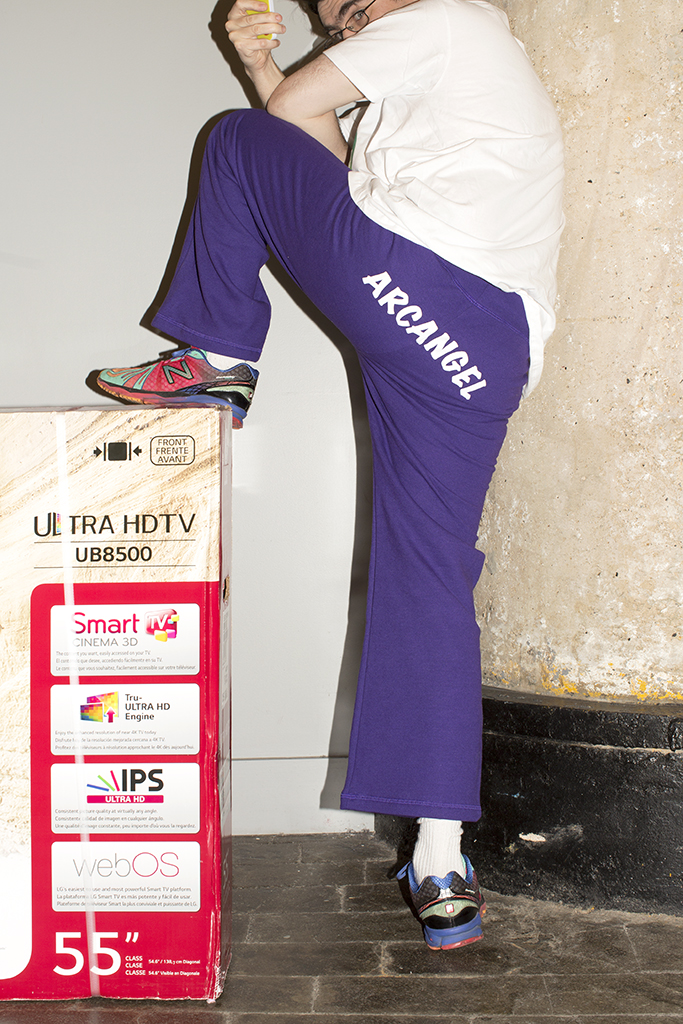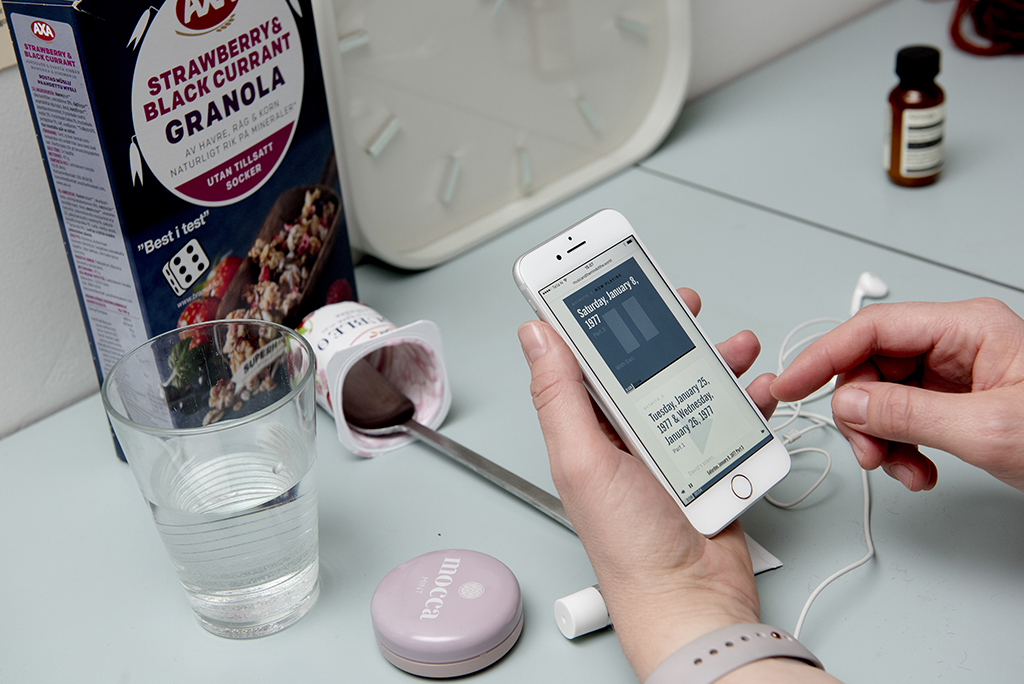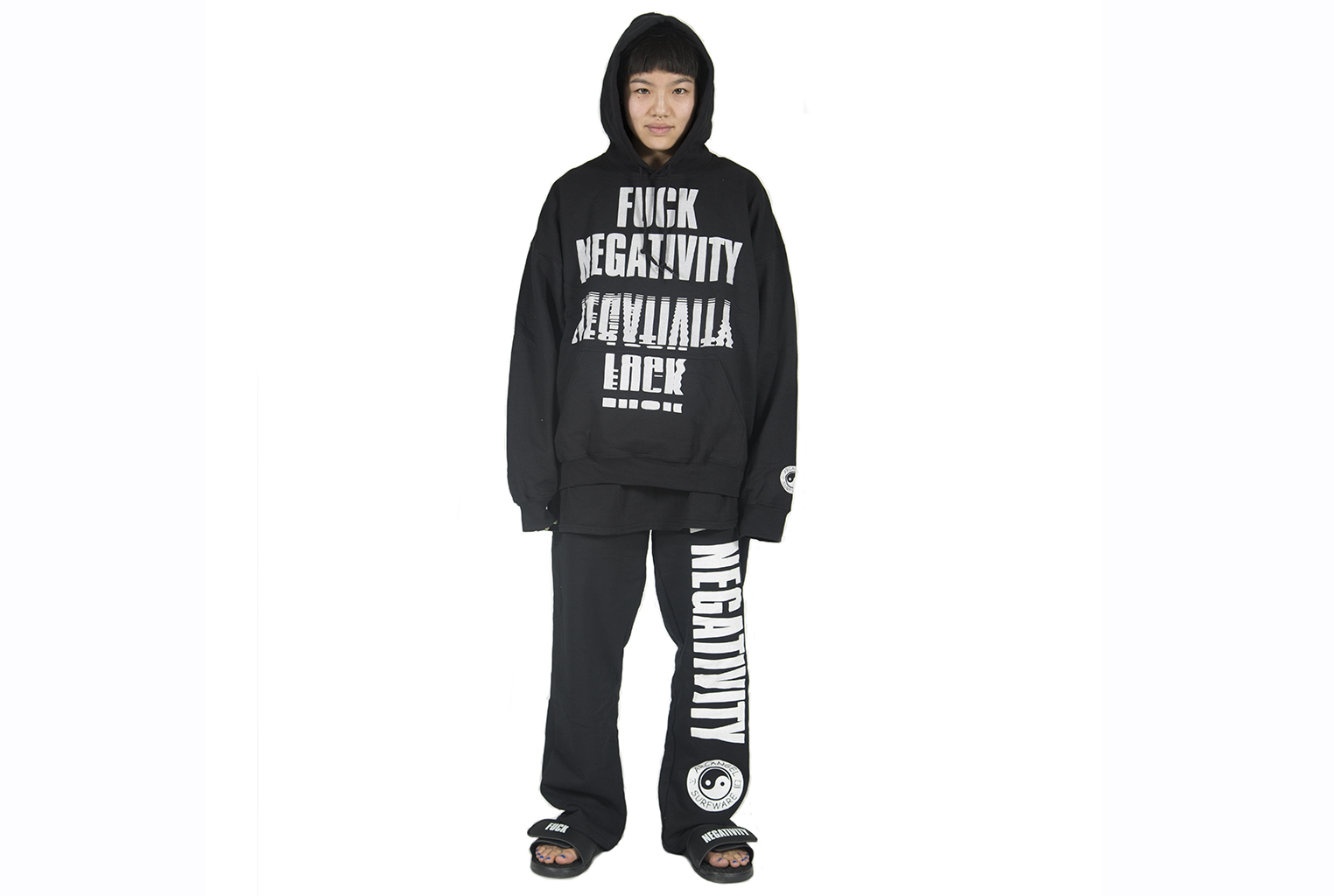We meet up on the west side of Stavanger center and walk together to the opposite side of town to meet with American artist Cory Arcangel to talk with him about the opening of his new store, Arcangel Surfware. Though Arcangel Surfware as a project has existed since 2014, the first & only flagship store opens in Stavanger øst on May 5, 2018 When we finally get there (it’s quite a walk, but a beautiful day) we can see that the one room store already has a sign out front and printed paper with the distinctive ying–yang logo covering the window that reads: Arcangel Surfwear “Kommer snart”. It’s our interview, but as we arrive he puts his head out the doorway and is the first one to ask a question: Coffee? It’s a resounding YES from us. After getting two coffees and one mint tea to go, he shows us around the new space.
Cory Arcangel: It’s a mess right now.
He proceeds to show us around the space. It’s small, not quite square, freshly painted and carpeted. There are various boxes, cases, tech equipment and artwork stacked around the perimeter of the room.
CA: This is going to be a video wall, with three monitors stacked on top of each other, with an editorial advertisement video like you might see in the airport. So that will serve as a wall, with office and storage behind it, and with the front desk out in front of the screens. (He marks an area where the desk will be.) I’ll sit here when the shop is open.
HJ: When will the shop be open?
CA: From 12–3 on Saturdays only.
He continues to describe the store, showing us design elements that were made at a local steel factory in Klepp. Arcangel wrote a computer program to randomly punch designs into large, industrial steel plates with specifically designed machinery.
CA: This is all going to go away and this little section is going to be the gallery, he says, pointing to a very small section of the room located by the only window.
The first show will have a projection on this wall. It will be Burt Barr, Watching the Paint Dry: Red. Do you know this video? It’s an eight–minute video of paint drying. It’s just a red video. It’s one of my favorite videos.
And then there will be products and other artworks on the slat wall. It will look very slick but also a little bit messy. And these magazines I’m making, produced at Grafo Trykkeri, are coming next week too. So for sale there will be magazines, books, records, clothes, and fidget spinners. And then the gallery section. So that’s the plan.
The impression is that of a mixture of artworks and merchandise, where the lines between studio, gallery, and shop are blurred. The small room is filled with delightful contradiction. After the brief tour, Arcangel pulls out a few folding chairs and we dig more deeply into how he negotiates the different entities that comprise his practice.
HJ: Is the store an art project?
CA: Haha, lol. You are getting right into it. Do you mean legally, in terms of tax law?
HJ: No conceptually. How are you thinking of it? Is it an art project or is it a business, or some combination thereof?
Astrid Helen Windingstad: That was also my question. When we were talking about the space the other day you were saying it’s kind of a shop, kind of a gallery, and that you like the lack of clarity.
CA: You know you’re the first people to talk to me about this so I don’t have any answers yet. Lets start with the practical. It will function as an actual shop – physically, people will be able to come here and buy things as if they are buying them in any normal shop. And then this little section over here will be a gallery. In terms of how it works in my larger practice, with Surfware I’m always trying to make it like a real business… But it hasn’t quite happened yet.
AHW: Do you have ambitions to do that? Is that the goal of the project?
CA: I have a type of ambition, but in the end the decisions for the – I don’t want to call it a brand because I don’t think people don’t use that word anymore – the decisions for this project is that trying to produce an art moment always takes precedence over commerce. So I’m always making decisions that don’t make any sense! For example opening this store in Stavanger East that’s only open 3 hours a week – that is a decision that in terms of commerce does not make any sense. But in terms of doing something interesting, and a bit in–accessible – which is a bit closer art – it makes a lot of sense.
HJ: I had to ask, but I was nervous asking this question because years ago, I was listening to an interview with Tracey Emin. She had a shop with Sarah Lucas. The man who was interviewing her was talking about commerce as art and shop as art and they went round and round about it. And she finally got mad and said “no, we had a shop and we ran a shop! …You’ve got a shop, people come into the shop, and people buy things and they give you money for them and you put them in a bag and they leave. It was a shop.” I think it’s fine either way, but I’m curious about how you’re thinking about it. Because you have Cory Arcangel, your artwork, and you have Arcangel Surfware, which is this other entity. And now you have the shop and the gallery. How do you see these interacting?
CA: Yeah! That’s one of the famous artist shops. Well the shop is the Arcangel Surfware flagship and the gallery is Flagship AS. So the gallery is actually going to have a separate name, and profile. But the good thing about this Arcangel Surfware project is that is has no direction or ambition or purpose. So if it turns out that the gallery is more fun to run than the shop than maybe next year it will just turn into a gallery. I have no goals.
HJ: So for the record, what is Arcangel Surfware?
CA: We have a new tagline! We make both merchandise and software so the new line is: Arcangel Surfware is a multinational software and merchandise publisher based in New York and Stavanger.
HJ: That sounds very shiny.
CA: Yes! Hahahaa.
HJ: But practically speaking, what does Arcangel Surfware do? It’s no longer just an online shop.
CA: It is a merchandise and software publisher. So we produce software, like the Tony Conrad Music and the Mind of the World website, of the the twitter bot that we also made to go with that. We also publish clothes and books. Each year we try to do a collection. Our 2017 collection was fidget spinners. The 2016 collection was clothes. The 2015 was also clothes. And in 2014, it was records and magazines and bedding. And upcoming I don’t know! The store! I didn’t make anything new for the store. The store is what’s new.

HJ: But why did you start Arcangel Surfware to begin with? What was the impetus behind that?
CA: It started in 2014 because I was approached by Bravado which is a company that is owned by Universal. They approached me and they wanted to do a merchandise deal so I started it for that deal. We no longer work with Bravado so it’s totally independent now. I said yes to them and then I had to come up with some idea. And then it made sense to do… you know Lil Wayne has Truck Fit and Drake has OVO. I wanted to have my own kind of related but semi–unrelated thing like Truckfit and OVO.
HJ: Are there other artists in the contemporary art world doing something similar? It seems more common in the music world.
CA: I’ve been looking / inspired by similar projects like Badlands Unlimited, Diagonal Press, Atelier AB, The Serving Library, Are.na and Science Ltd.
HJ: What do you think is the draw of commerce in the cultural field? Is it a way to make money or a way to do something more practical?
CA: Its not a good way to make money, and its definitely impractical! Well, when I’ll be tending the shop, and I think it’s nice that people can come buy my stuff. It’s very one to one, and kinda the opposite of the things I have done in the last 20 years, which was network based. Secondly, I wanted to take control of my publishing. So artist books – we published our first book a year ago. So if I had an idea for an artist book or if I wanted to do my own catalogue I wanted the option to always be able to do it myself and not rely on a publisher. So that was kind of the practical thought, taking control of my own business.
HJ: Are you doing other artist books as well? I’m asking in relation to the gallery since you will now be working with other artists for the first time.
CA: The last big project we did with Arcangel Surfware was 2017’s Tony Conrad’s Music and the Mind of the Word publication. Yes, I want to work more in that direction. To have it not be so much based around my own work. To have move towards collaborations with other people. And, even though we’re opening up a store, it seems like it’s quite possible that what the brand does will become less and less … physical. Maybe we’ll just release software.
AHW: You don’t have any plans to open a store in New York?
CA: No. I have some plans to continue to do little pop–ups here and there.

AHW: I can feel you are very passionate about it, as much as you would be to your art. You’ve paid attention to every detail.
CA: Yeah and it’s a test, a way to test things in an real environment. Like these pieces are tests. And now they’re here and they look good so I’m like ok, I did that!
HJ: What’s the desire to start the gallery? And do you have programming planned already?
CA: Just Burt Barr. The show will play until the fall and after that I want to do two shows a year – if I really get my shit together three shows a year. No, for the gallery I have high ambitions let’s say. … since it’s only one work per artist, and only two shows a year, I feel like I could really get it going.
HJ: Only one work?
CA: Yeah.. ha!
AHW: I’m looking forward to seeing what’s going to show up.
CA: Yeah me too! When I organized the show at Prosjektrom Normanns with Jacob Ciocci I just saw how much everyone loves to come here – to Stavanger. People love it here! So the gallery is an engine for me to keep that kind of thing happening.
HJ: Why do you think people love Stavanger so much?
CA: I think it has to do with the ocean always in your sightline. That, and the air is a lot cleaner here. The cars stop for you on the road. The architecture is really cool. I think all these things combined are why people like being here. Oh and the food is really good! We forget it when we’re here for awhile. If somebody came here for a week, every meal they have would be super fresh. When Jacob came it was berry season and I was like let’s go to the center of town and get a pound of these handpicked berries you’ve never heard of before. It’s super fresh and exotic.
AHW: Also it’s a trend in the US, these small Scandinavian countries. A vision of the slow life.
CA: Yeah! Work life balance. No reason to rush. And for me putting this store together was also a way to build a local production muscle. Because that’s what I do for a living is make stuff. I didn’t like always making things in New York – it made me feel weird. And I found that weirdly, I think it’s easier to make things here. Stavanger has such a strong manufacturing culture so it’s surprising how many things you can get made here easily. You also don’t have to nag people. When somebody says something is going to happen on Thursday, it will literally happen on Thursday.

AHW: It’s a different way for you to work isn’t it? In New York you have a studio with assistants…
CA: Yeah its more like the way I worked 20 years ago. Where I’m on the phone and emailing and doing everything.
HJ: But it’s still your creative project. It’s not just all logistics, right?
CA: Creativity is logistics.
AHW: So it’s different from the way you usually work which is more conceptual. Here it’s both, a conceptual vision and practical work.
CA: Yes, exactly. We’re also redesigning the website with Benjamin Hickethier which is going to be cool. He designed a very beautiful website last week for Arcangel Surfware.
HJ: You’re doing a whole new website? Is that also launching May 5?
CA: Yes. We took down our web store. The brand is only available right now in the flagship. Indefinitely. Maybe that’s the way it has to be from now on.
HJ: Also not smart in regards to commerce.
CA: Haha! Yeah also not smart. But I kind of like it. Now you actually have to come to Stavanger to buy this stuff.
HJ: Do you have future plans after the opening?
CA: My only plan at the moment is to make it to the opening on May 5th.
The conversation slowly moved away from the under–construction flagship store to beers, cheese fries, and conversations about toddler sleep at Øst, a local bar just around the corner from the new store that overlooks the fjord. The bar itself is adjacent to Tou Scene, an art center and studio building, illustrating clearly the mycelial network of artists, spaces, and cultural producers that have taken up residence in this small city on the west coast of Norway.
Cory Arcangel (b. 1978, Buffalo, NY) is an artist and entrepreneur who lives in Stavanger, Norway and works in New York, who makes work in a wide range of media. He recently opened the touring two–person show, “Asymmetrical Response” with Olia Lialina which traveled to the Western Front in Vancouver, the Kitchen in New York, and Art Projects Ibiza in Ibiza. His work is included in many public collections, including the MoMA in New York, the Tate in London, Berlin’s Neue Nationalgalerie, and the Migros Museum für Gegenwartskunst in Zürich.


